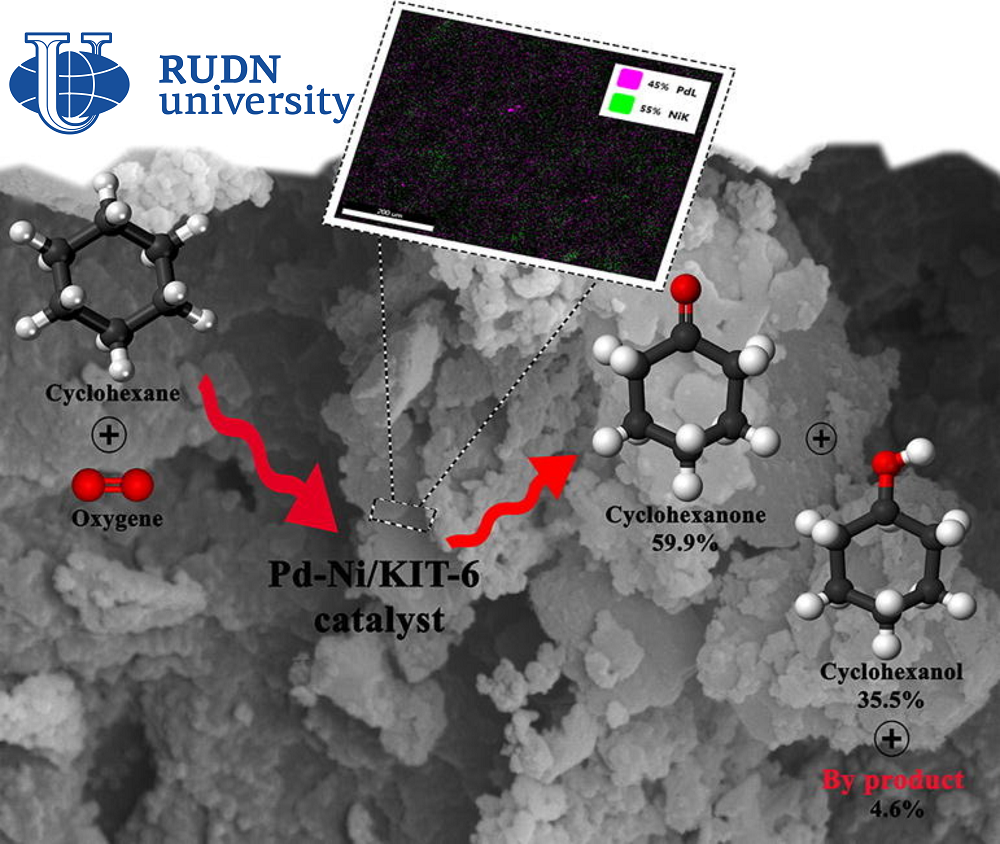The chemist RUDN created a catalyst for more efficient oxidation of cyclohexane

A mixture of cyclohesanol and cyclohesanone (these are two cyclic organic compounds that differ from each other by one hydrogen atom) is an important intermediate for the production of adipic acid. It is used for the production of household chemicals, building materials, food additives, polymers and other substances. In the production of cyclohexanol and cyclohesanone are obtained by oxidation of cyclohesan, and usually no more than 5% of the original cyclohesan is converted into the desired product. This is due to the fact that cyclohesanol and cyclohesanone have greater reactivity than their predecessor.
“The oxidation of cyclohexane to cyclohexanone and cyclohexanol is an important industrial process. These molecules are key intermediates in the production of caprolactam and adipic acid, which are used in the synthesis of nylon-6 and nylon-66 polymers. The industrial conversion of the matrix is usually less than 5%, since the target products are more active than the reagent,” — Rafael Luque, professor at the Center for Molecular Design and Synthesis of Innovative Compounds for Medicine of the RUDN.
The chemist RUDN together with colleagues from Iran and Spain created a catalyst 4.0%Pd-4.0%Ni/KIT-6 based on two metals — palladium and nickel, which are fixed on a porous structure of silicon dioxide. Chemists tested catalysts with different palladium and nickel contents, and also conducted a series of experiments to find optimal reaction conditions. The researchers then tested how many times the new catalyst could be used without loss of efficiency.
The most effective was a catalyst with 4% palladium and 4% nickel. The oxidation reaction of cyclohexane with such a catalyst takes place under the action of oxygen at 140 ℃ in an acetonitrile solution. In eight hours of reaction, 10.87% of cyclohexane is oxidized, and selectivity reaches 95.45%. This criterion is used to evaluate the effectiveness of the reaction and shows the ratio of the target product to all compounds obtained during the reaction. Under optimal conditions, only 4.55% of by-products are formed. With repeated use, the efficiency of the catalyst decreases, but not much. Over four cycles of use, the conversion rate (the amount of oxidized cyclohexane) dropped from 10.87% to about 8%.
“4.0%Pd-4.0%Ni/KIT-6 proved to be an effective catalyst for the oxidation of cyclohexane to cyclohexanol and cyclohexanone, showed excellent selectivity (95.45%) and good yield (10.37%) for the cyclohesanol-cyclohesanone mixture under optimal reaction conditions. The synergistic interaction of the two metals in the catalyst significantly increased both the yield of the final mixture and selectivity. Studies of the possibility of reuse of the new catalyst during four reaction cycles have shown that this material has retained its porous structure. This indicates excellent stability without a significant decrease in conversion values and selectivity after four cycles,” — Rafael Luque, professor at the Center for Molecular Design and Synthesis of Innovative Compounds for Medicine of the RUDN.
The results are published in the Journal of Industrial and Engineering Chemistry.
RUDN summarized the results of the scientific competition "Project Start: work of the science club ". Students of the Faculty of Physics, Mathematics and Natural Sciences have created a project for a managed queuing system using a neural network to redistribute resources between 5G segments. How to increase flexibility, make the network fast and inexpensive and reach more users — tell Gebrial Ibram Esam Zekri ("Fundamental Computer Science and Information Technology", Master's degree, II course) and Ksenia Leontieva ("Applied Mathematics and Computer Science", Master's degree, I course).
The National Demographic Report, 2023 Demographic Well-Being of Russian Regions (hereinafter - the National Demographic Report) was prepared by the scientific team of the Institute of Demographic Studies of the Federal Research Center of the Russian Academy of Sciences, the Vologda Scientific Center of the Russian Academy of Sciences, Peoples' Friendship University of Russia, the Center for Family and Demography of the Academy of Sciences of the Republic of Tatarstan, as well as with the participation of leading scientists from the Republic of Bashkortostan, Stavropol Krai, Volgograd, Ivanovo, Kaliningrad, Nizhny Novgorod, Sverdlovsk Oblasts and Khanty-Mansi Autonomous Okrug–Yugra.
RUDN summarized the results of the scientific competition "Project Start: work of the science club ". Students of the Faculty of Physics, Mathematics and Natural Sciences have created a project for a managed queuing system using a neural network to redistribute resources between 5G segments. How to increase flexibility, make the network fast and inexpensive and reach more users — tell Gebrial Ibram Esam Zekri ("Fundamental Computer Science and Information Technology", Master's degree, II course) and Ksenia Leontieva ("Applied Mathematics and Computer Science", Master's degree, I course).
What is your first association with the word “laboratory”? Flasks and beakers? Microscopes and centrifuges? Yes, many of us would answer the same way.
The National Demographic Report, 2023 Demographic Well-Being of Russian Regions (hereinafter - the National Demographic Report) was prepared by the scientific team of the Institute of Demographic Studies of the Federal Research Center of the Russian Academy of Sciences, the Vologda Scientific Center of the Russian Academy of Sciences, Peoples' Friendship University of Russia, the Center for Family and Demography of the Academy of Sciences of the Republic of Tatarstan, as well as with the participation of leading scientists from the Republic of Bashkortostan, Stavropol Krai, Volgograd, Ivanovo, Kaliningrad, Nizhny Novgorod, Sverdlovsk Oblasts and Khanty-Mansi Autonomous Okrug–Yugra.